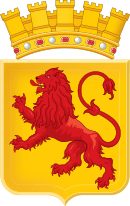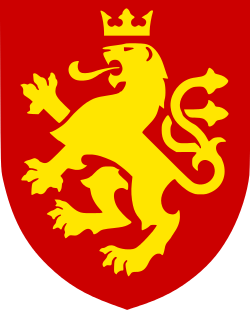National emblem of the Republic of Macedonia
| National Emblem of Macedonia | |
|---|---|
 | |
| Details | |
| Armiger | Republic of Macedonia |
| Adopted | 16 November 2009 |
| Escutcheon | The national emblem of the Republic of Macedonia is composed of two curved garlands of sheaves of wheat, tobacco leaves and opium poppy fruits, tied by a ribbon decorated with embroidery of traditional Macedonian folk motifs. In the centre of the ovoid frame are depicted a mountain, a lake and a sunrise. These devices are said to represent "the richness of our country, our struggle and our freedom" |
The national emblem of the Republic of Macedonia depicts two curved garlands of sheaves of wheat, tobacco leaves and opium poppy fruits, tied by a ribbon decorated with embroidery of traditional Macedonian folk motifs. In the centre of the ovoid frame are depicted a mountain, a lake and a sunrise.[1] The features of the national coat of arms contain a rising sun which symbolizes freedom, the Šar Mountains[2] with its peak named Ljuboten[2] or Mount Korab[3] and the river Vardar,[2][3] with Lake Ohrid. The emblem also contains opium poppy fruits; this poppy was brought to Macedonia by the Ottoman Empire in the first half of the 19th century.[4] Until 16 November 2009, the emblem also depicted a socialistic five-pointed star in the top. The national parliament adopted the proposal to remove this element with 80 votes in favor and 18 against. The emblem that included the red star had been in use since 1946, shortly after the republic became part of the former Socialist Federal Republic of Yugoslavia (SFRY).
The emblem is based upon the Emblem of Yugoslavia and is unrelated to the historical coats of arms of Macedonia. Along with Belarus, the Republic of Macedonia is one of the few remaining European countries that continue to employ socialist symbolism.
History
The current emblem is a revised version of the one adopted on July 27, 1946 by the Assembly of the People's Republic of Macedonia. The original version of 1946 represented the Pirin Mountains which are part of the region of Macedonia in order to symbolize a future United Macedonia as part of a new Balkan Federation. The Emblem was created by Vasilije Popovic-Cico.[5] After Yugoslavia broke with the Soviet Union in 1948, the Soviet Union did not compel Bulgaria and Albania to form a Balkan Federation with Yugoslavia and the concept of a United Macedonia as part of such a federation was no longer realistic.[6]
Two days after its adoption, the symbolism of that device was described in the Nova Makedonija newspaper, as follows:
The [coat of arms] of the People's Republic of Macedonia is a symbol of the freedom and the brotherhood of the Macedonian people and the richness of the Macedonian land. The five-pointed star symbolizes the National Liberation War through which the Macedonian people gained freedom. In the center, there is the Pirin mountain, the highest Macedonian mountain that has been the center of the National Liberation Wars in the past. The river displayed in the emblem is the river Vardar, the most famous Macedonian river in the republic. Pirin and Vardar at the same time symbolize the unity of all parts of Macedonia and the ideal of our people for national unity.[6]
The supervised version was constitutionally approved by the Constitution of the People's Republic of Macedonia from December 31, 1946.[7]
 Emblem of the People's Republic of Macedonia, 1944-1946
Emblem of the People's Republic of Macedonia, 1944-1946 Emblem of the Socialist Republic of Macedonia, 1946-1991
Emblem of the Socialist Republic of Macedonia, 1946-1991.svg.png) Emblem of the Republic of Macedonia, 1991-2009
Emblem of the Republic of Macedonia, 1991-2009
Proposed heraldic replacement
Between the 14th and the 19th centuries foreign armorials commonly represented "Macedonia" by means of a golden lion on red field or of a red lion on a golden field.[8][9] The earliest known example of this is the Fojnica Armorial[10] from 1340, and later examples include the Korenić-Neorić armorial of 1595, a 1630 armorial on display in the Belgrade Museum of Contemporary Art and a 17th-century armorial in Berlin Library.[11]
On several occasions the reintroduction of the historical coat of arms has been proposed. A proposal by architect and graphic designer Miroslav Grčev was put forward in 1992 to replace it with a revised version of the historical gold lion on a red shield. The Macedonian Heraldry Society considers that coat of arms to have been the best solution for a new state emblem.[12] However, this was rejected on three main grounds:
- several political parties, notably VMRO-DPMNE, already use that emblem as their party symbols
- the Albanian political parties of Macedonia considered the proposal to be only representative for the ethnic Macedonians, but not also for ethnic Albanians
- the state coat of arms of Bulgaria is identical to the Macedonian proposal save for the design of the crown.
As a result, the political parties have agreed to continue to use the current device until a replacement is found. The emblem did not appear on the country's first passports. In 2007, however, the national emblem was put on the front and the inside of the new biometric Macedonian passports, while the parliamentary debate about acceptance of a new national emblem still continues.
According to the provisions of the Article 5, Section 2 of the Constitution of Macedonia, the two-thirds majority is required to pass a law on the new symbols of the Republic. The usage of the Coat of arms has been defined by a law.[13]
2014 proposal
On the 5 December 2014, the Macedonian government proposed a heraldic design which would replace the old national emblem. According to the president of the Macedonian Heraldry Society Jovan Jonovski, the new coat of arms is based on an illustration from Jerome de Bara (1581).[14] The illustration from de Bara's book "Le blason des armoiries" depicts a coat of arms attributed to Alexander the Great.[15] It is blazoned as "Or, a lion gules" (on a golden background, a red lion) and topped with a golden mural crown to represent the republican form of government. Parliament still needs to vote on this design.[16]
 One of the unofficial proposals for a new coat of arms
One of the unofficial proposals for a new coat of arms Coat of arms proposed in 2014 by the Macedonian government[14]
Coat of arms proposed in 2014 by the Macedonian government[14] Coat of arms proposed in 1992, by Miroslav Grčev. This was the most popular proposed arms before the government's 2014 proposal.
Coat of arms proposed in 1992, by Miroslav Grčev. This was the most popular proposed arms before the government's 2014 proposal.
See also
References
| Wikimedia Commons has media related to Coats of arms of Macedonia. |
- ↑ "Macedonia: Coat of arms". flagspot.net.
- 1 2 3 World Around Us — the Encyclopaedia for Children and Youth, XI edition, Školska knjiga, Zagreb, 1987, vol. II (A-M), page 242
- 1 2 Со замената на сликата се менува и објаснувањето, Пирин преоѓа во Кораб
- ↑ Agricultural Encyclopaedia, Yugoslavian Lexicographical Institute, Zagreb, 1970, vol. II (Krm-Proi), page 131, Author of the article on Poppy is Jordan Đorđevski, dipl. ing. agr., professor of the Agricultural and Forestry Faculty of the University of Skopje, Macedonia
- ↑ Jonovski, Jovan. "Coats of arms of Macedonia (Macedonian Herald, Electronic Version @ heraldika.org.mk, No. 3, March 2009., p. 9)" (PDF). heraldika.org.mk.
- 1 2 62nd birthday of the national emblem of the Republic of Macedonia
- ↑ Ustav na Narodna Republika Makedonija ("Služben vesnik", No. 1/47, 1947-01-01)
- ↑ Matkovski, Aleksandar, Grbovite na Makedonija, Skopje, 1970
- ↑ Александар Матковски (1990) Грбовите на Македонија, Мисла, Skopje, Macedonia - ISBN 86-15-00160-X
- ↑ Fojnica Armory, online images
- ↑ Macedonian heraldry
- ↑ "The most acceptable design was of Miroslav Grcev, professor of architecture"
- ↑ Zakon za upotreba na grbot, znameto i himnata na Republika Makedonija ("Služben vesnik na Republika Makedonija", No. 32/97, 1997-07-09)
- 1 2 "Government adopts draft-law on new Macedonia's coat of arms".
- ↑ "Le blason des armoiries". google.com.
- ↑ "Macedonia with new state emblem". Gazeta Express (in Albanian).
